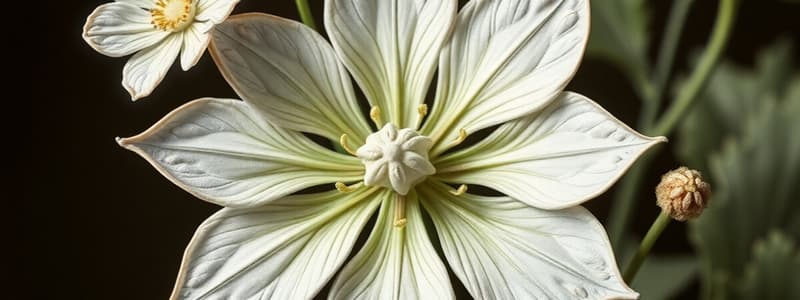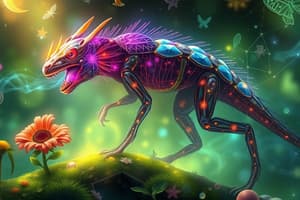Podcast
Questions and Answers
Which of the following is an example of a Chrysophyte?
Which of the following is an example of a Chrysophyte?
- Penicillium
- Diatoms (correct)
- Trypanosoma
- Euglena
What is the cell wall of diatoms made of?
What is the cell wall of diatoms made of?
- Pellicle
- Cellulose
- Protein
- Silica (correct)
Which organism possesses a stiff cellulose cell wall?
Which organism possesses a stiff cellulose cell wall?
- Euglenoids
- Diatoms
- Phycomycetes
- Dinoflagellates (correct)
Which of these is a flagellated protozoan?
Which of these is a flagellated protozoan?
Which of the following is an example of asexual spores in fungi?
Which of the following is an example of asexual spores in fungi?
Which of the following is considered the first successful land plant?
Which of the following is considered the first successful land plant?
Which plant has microphylls?
Which plant has microphylls?
Which of these plants has mycorrhiza?
Which of these plants has mycorrhiza?
Which of the following exhibits cellular grade organization?
Which of the following exhibits cellular grade organization?
Which of the following animals are acoelomates:
Which of the following animals are acoelomates:
Which of the following is a disease caused by prions?
Which of the following is a disease caused by prions?
Which of these plants is an example of an insectivorous plant?
Which of these plants is an example of an insectivorous plant?
Which algae demonstrates isogamous non-motile reproduction?
Which algae demonstrates isogamous non-motile reproduction?
Which of the following is classified under Deuteromycetes?
Which of the following is classified under Deuteromycetes?
Which of the following is a liverwort?
Which of the following is a liverwort?
Which of the following organisms reproduces through budding?
Which of the following organisms reproduces through budding?
In the five-kingdom classification system, what is NOT a basis for classification?
In the five-kingdom classification system, what is NOT a basis for classification?
Which kingdom do bacteria belong to?
Which kingdom do bacteria belong to?
What is the primary component of the cell wall in fungi?
What is the primary component of the cell wall in fungi?
Which of the following is an example of a bacterial disease?
Which of the following is an example of a bacterial disease?
Which of these seeds is non-endospermic?
Which of these seeds is non-endospermic?
What type of fruit is a mango?
What type of fruit is a mango?
What is the ground tissue system?
What is the ground tissue system?
Which type of vascular bundle arrangement is typically found in monocot stems?
Which type of vascular bundle arrangement is typically found in monocot stems?
Where can ciliated epithelium be found?
Where can ciliated epithelium be found?
Which of these animals is classified under class Aves?
Which of these animals is classified under class Aves?
Which of the following mammals is viviparous?
Which of the following mammals is viviparous?
What type of root system does wheat have?
What type of root system does wheat have?
What is the primary function of pneumatophores in Rhizophora?
What is the primary function of pneumatophores in Rhizophora?
Which plant exhibits alternate phyllotaxy?
Which plant exhibits alternate phyllotaxy?
Which type of flower symmetry is exhibited by mustard plants?
Which type of flower symmetry is exhibited by mustard plants?
Which of the following plants has asymmetrical flowers?
Which of the following plants has asymmetrical flowers?
What type of ovary does a hypogynous flower possess?
What type of ovary does a hypogynous flower possess?
In valvate aestivation, as seen in Calotropis, what is the arrangement of sepals or petals?
In valvate aestivation, as seen in Calotropis, what is the arrangement of sepals or petals?
What is the term for stamens attached to petals?
What is the term for stamens attached to petals?
Which term describes a sterile stamen?
Which term describes a sterile stamen?
What type of gynoecium is found in a mustard plant?
What type of gynoecium is found in a mustard plant?
Which family does wheat (Triticum aestivum) belong to?
Which family does wheat (Triticum aestivum) belong to?
Which phylum includes organisms with a pseudocoelom?
Which phylum includes organisms with a pseudocoelom?
Which of the following organisms belongs to the phylum Porifera?
Which of the following organisms belongs to the phylum Porifera?
To which phylum does the organism Physalia belong?
To which phylum does the organism Physalia belong?
Which of the following is a common name for organisms in the phylum Annelida?
Which of the following is a common name for organisms in the phylum Annelida?
Which of the following animals is a Platyhelminthes?
Which of the following animals is a Platyhelminthes?
Which of these animals is an example of an Arthropoda?
Which of these animals is an example of an Arthropoda?
Which of the following organisms belongs to the phylum Mollusca?
Which of the following organisms belongs to the phylum Mollusca?
Which of the following is an example of a reptile?
Which of the following is an example of a reptile?
Which of the following is a freshwater fish?
Which of the following is a freshwater fish?
Which of these animals has a diploblastic organization?
Which of these animals has a diploblastic organization?
Where is smooth muscle found in the body?
Where is smooth muscle found in the body?
What type of junction is present in cardiac muscle?
What type of junction is present in cardiac muscle?
What is considered the smallest cell?
What is considered the smallest cell?
Which of these structures stores carbohydrates?
Which of these structures stores carbohydrates?
Which of these cell organelles is surrounded by a single membrane?
Which of these cell organelles is surrounded by a single membrane?
Flashcards
Pteridophytes
Pteridophytes
Plants that successfully adapted to land, known for their vascular system.
Strobili (Cones)
Strobili (Cones)
A structure in some pteridophytes like Selaginella and Equisetum that contains spores.
Gymnosperm Characteristics
Gymnosperm Characteristics
Gymnosperms have exposed seeds, are typically woody plants, and include both branched and unbranched species.
Tissue Grade of Organization
Tissue Grade of Organization
Signup and view all the flashcards
Acoelomates
Acoelomates
Signup and view all the flashcards
Plankton
Plankton
Signup and view all the flashcards
Gonyaulax
Gonyaulax
Signup and view all the flashcards
Pellicle
Pellicle
Signup and view all the flashcards
Fungi Classification
Fungi Classification
Signup and view all the flashcards
Rhizopus
Rhizopus
Signup and view all the flashcards
Taxon
Taxon
Signup and view all the flashcards
Five Kingdom Classification
Five Kingdom Classification
Signup and view all the flashcards
Basis of Five Kingdom Classification
Basis of Five Kingdom Classification
Signup and view all the flashcards
Halophiles
Halophiles
Signup and view all the flashcards
Heterocyst
Heterocyst
Signup and view all the flashcards
Basidiomycetes
Basidiomycetes
Signup and view all the flashcards
Deuteromycetes
Deuteromycetes
Signup and view all the flashcards
Insectivorous Plants
Insectivorous Plants
Signup and view all the flashcards
Prions
Prions
Signup and view all the flashcards
Isogamous (Motile)
Isogamous (Motile)
Signup and view all the flashcards
Primary Root
Primary Root
Signup and view all the flashcards
Adventitious Root
Adventitious Root
Signup and view all the flashcards
Stem Tendril
Stem Tendril
Signup and view all the flashcards
Reticulate Venation
Reticulate Venation
Signup and view all the flashcards
Alternate Phyllotaxy
Alternate Phyllotaxy
Signup and view all the flashcards
Endospermic Seeds
Endospermic Seeds
Signup and view all the flashcards
Non-Endospermic Seeds
Non-Endospermic Seeds
Signup and view all the flashcards
Drupe Fruit
Drupe Fruit
Signup and view all the flashcards
Sclereids
Sclereids
Signup and view all the flashcards
Guard Cell (Dumbbell Shaped)
Guard Cell (Dumbbell Shaped)
Signup and view all the flashcards
Smallest Cell
Smallest Cell
Signup and view all the flashcards
Largest Single Cell
Largest Single Cell
Signup and view all the flashcards
Inclusion Bodies
Inclusion Bodies
Signup and view all the flashcards
Amyloplast Function
Amyloplast Function
Signup and view all the flashcards
Active Transport
Active Transport
Signup and view all the flashcards
Actinomorphic
Actinomorphic
Signup and view all the flashcards
Zygomorphic
Zygomorphic
Signup and view all the flashcards
Hypogynous Flower
Hypogynous Flower
Signup and view all the flashcards
Perigynous
Perigynous
Signup and view all the flashcards
Epigynous
Epigynous
Signup and view all the flashcards
Valvate Aestivation
Valvate Aestivation
Signup and view all the flashcards
Twisted Aestivation
Twisted Aestivation
Signup and view all the flashcards
Imbricate Aestivation
Imbricate Aestivation
Signup and view all the flashcards
Diploblastic
Diploblastic
Signup and view all the flashcards
Triploblastic
Triploblastic
Signup and view all the flashcards
Pseudocoelomate
Pseudocoelomate
Signup and view all the flashcards
Phylum Porifera
Phylum Porifera
Signup and view all the flashcards
Phylum Coelenterata
Phylum Coelenterata
Signup and view all the flashcards
Phylum Platyhelminthes
Phylum Platyhelminthes
Signup and view all the flashcards
Phylum Aschelminthes
Phylum Aschelminthes
Signup and view all the flashcards
Phylum Annelida
Phylum Annelida
Signup and view all the flashcards
Study Notes
Pteridophytes
- Pteridophytes were the first successful land plants.
- Equisetum (horsetail) are Pteridophytes with cone and rhizome.
- Selaginella and Equisetum are Pteridophytes that have Strobiti (or cones).
- Ferns feature microphylls.
- Selaginella and Salvinia are heterosporous.
- Dryopteris and Pteris are homosporous.
Gymnosperm
- Wolffia and Eucalyptus are the smallest and tallest trees, respectively.
- Pinus cedrus is a branched gymnosperm.
- The unbranched version is Cycas.
- Mycorrhiza is present in Pinus.
- Coralloid roots are present in Cycas.
- Sequoia are the largest gymnosperm.
- Pinus is monoecious.
- Cycas is dioecious.
- Male and female cones are in Pinus.
- Only male cone is present in Cycas.
Angiosperm
- Wolffia is the smallest plant.
- Eucalyptus is the tallest plant.
Animal Kingdom
- Protozoan exhibit the Protoplasmic level of organization.
- Porifera exhibit the cellular grade of organization.
- Coelenterata and Ctenophora exhibit tissue grade organization.
- Platyhelminthes show an organ level of organization.
- Aschelminthes to chordata exhibit the organ system level of organization.
- Porifera are mostly asymmetrical.
- Coelenterata, Ctenophora, and adult Echinodermata have radial symmetry.
- Platyhelminthes to Chordata, and larva of Echinoderms display bilateral symmetry.
- Platyhelminthes are acoelomates.
Studying That Suits You
Use AI to generate personalized quizzes and flashcards to suit your learning preferences.




